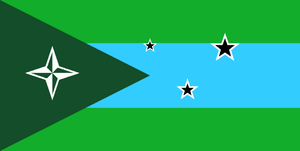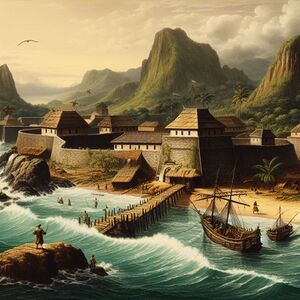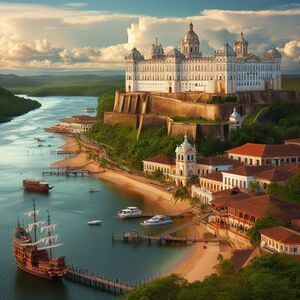Seváronsa
| Territory of Seváronsa Skírēn Seváronsa | |
 Flag | |
| Country | |
| Theme | |
| Capital and largest city |
Havre de Grace |
| Population | 776,732 |
| Governor | Sanovordus U.B.I. Iśikarin |
| President | Palladius Walowakuv (SU) |
| Legislature | Legislative Assembly |
| Stanora seats | 2 |
| Official languages | Kiravic Coscivian |
| Recognised languages | Portuguese, Barikol, Karluki |
| Postal Abbreviation | SVÁ |
| Time Zone | Central Cronan Time |
Seváronsa, officially the Seváronsa Territory, is an overseas territory of the Kiravian Federacy, occupying three islands in the Sea of Orixtal.
Geography
Seváronsa comprises three major islands: Lordaseváronsa ("Grand Seváronsa"), Lesser Seváronsa, and the more distant Karluk. The islands are surrounded entirely by water, not far beyond which are the Alstinian islands of [Name] and [Name] and [Name]. Nearby also are the Solemias, a possession of Cartadania.
The territory has a tropical climate.
History
Seváronsa was first settled by the ancestors of the Barikol people. The Barikol people were tribally organised for most of their history. Their political development progressed such that territorial chiefdoms had begun to consolidate themselves in more densely populated areas of Great Seváronsa and Lesser Seváronsa by the time of colonisation.
St. Nicholas Colony
Main article: St. Nicholas Colony

Seváronsa was visited by traders of various nationalities early in the Age of Exploration, though Bergendii and Kiravians were the most frequent callers. The Bergendii navigator Jean-Zechariah Gullouing deLoreanne purchased the area enclosing a commodious natural harbour on Great Seváronsa from the native chief Bumi the Duped in exchange for an assortment of Levantine manufactures, including 11 leather boots (5 pairs and 1 lone right boot), four ear spoons, and two hats. There deLoreanne established a trading post and way station which he dubbed Havre de Grace. Burgundie achieved suzerainty over Great Seváronsa in 1654 and called it St. Nicholas Colony, which was later extended to the other two islands, which were collectively absorbed into the Burgoignesc Thalattocracy in 1876 after the unification of Burgundie following the First Fratricide.

St. Nicholas Colony was attacked by Kiravian naval forces and privateers several times during the Kiro-Burgoignesc Wars, but was never captured or occupied. It was, however, offered as a bargaining chip during peace negotiations to end the War of St. Brendan's Strait in 1896 and ceded to Kiravian control under the terms of the resulting Treaty of Kurst.
Kiravian rule
Under Kiravian rule, Seváronsa became an important part of the Kiravian maritime colonial and commercial network, serving as a way station for vessels travelling from Great Kirav, Æonara, Sarolasta, and the Krasoas to the Kiravian holdings in Cusinaut (chiefly Rovaion and Porfíria), and to various ports of call on the western seaboard of central and southern Crona. Coscivian settlers established plantations for various tropical crops, most prominently pineapple. Long-term contract workers, mainly from Sarolasta, would form the bulk of the agricultural labour force, and many of their descendants remain in Seváronsa today.
The advent of steam-powered navigation raised the strategic value of Seváronsa for Kiravia. It was to be indispensible as a coaling station for Kiravian warships and merchant steamers travelling between the far-flung Kiravian colonies. An undersea telegraph cable connecting Lesser Seváronsa to Sarolasta's Marian Isles was laid in 1904 AD.
A penal colony was founded on Karluk in 1907 which would remain in operation until 1939.[1]
Seváronsa was unaffected by the Kiravian Civil War. Seventy Seváronsan-born people are believed to have died in the war, mostly on the Federalist side, though it is unclear how many were domiciled in Seváronsa at the time of their deaths. A small number of anti-communist emigrés took up residence in Seváronsa as the tide of the war turned in favour of the Reds. No combat action took place anywhere near the islands, which remained firmly in Federalist hands and would be included in the Kiravian Remnant.
The Kiravian Sunderance was a fairly quiet time for Seváronsa. The growth of merchant vessel traffic among the scattered possessions of the Kiravian Remnant as they industrialised during this period was good for the local economy. The local military bases provided support for weapons testing, including nuclear weapons testing far out in the Ocean of Cathay. Land reform proceeded cautiously from 1952 onwards. Rural land value tax rates were kept low relative to Sarolasta or Æonara, and various deferments, exemptions, and carveouts were evisaged to blunt the impact of reforms on the profitable and politically influential pineapple plantations.The strengthening of the Kiravia-Alstin alliance during this era also brought many good things for the territory, increasing quality of life for residents by increasing their access to goods and services from the Alstinian market, and allowing them to travel to the neighbouring islands and Alstinian mainland more freely.
The completion of Kiravian Reunification also did not dramatically affect Seváronsa. None of the territory's military installations were closed, though advancements in naval architecture led to the decline of Havre de Grace as a refuelling stop for merchant vessels, which were increasingly capable of uninterrupted ocean crossings. The territorial Board of Labour Statistics claims that job losses due to this change have been offset by increased aviation and the growth of the service sector. Opinion polling data suggests that contemporary residents find life in contemporary Seváronsa to be generally satisfactory, and there is a strong sense of local pride and identity, especially among residents born on the islands. Nonetheless, the island territory often struggles to identify new drivers of economic growth and provide sufficient local employment opportunities for its youth, who often emigrate or work off-island for long periods of time.
Government
Seváronsa is chartered overseas territory within the Kiravian Collectivity. Its governmental structure and fundamental laws are laid out by the Territorial Charter of Seváronsa, promulgated by Prime Executive Eridan Vriẍur and validated by the Stanora in 1963 AD. The Governor of Seváronsa is appointed by the Prime Executive of the Kiravian Federacy for a regular term of three years, though a Governor may be replaced or recalled at any point in their term. Gubernatorial appointments are renewable indefinitely, though the usual practice since 21156 has been to re-appoint any governor in good standing to a second three-year term, and no more. Similarly, while the appointment is a unilateral prerogative of the Prime Executive, it has become customary since the 1990s for Kroveniren Hall to solicit the advice of local legislative leaders during the nomination process.
The territorial legislative body is known as the Legislative Assembly (Áldaktorix Skráliuv). Like many and contemporary and historical legislatures in the Coscivian-dominated world, it is a part-time body that meets twice annually for sessions of two weeks each. The Legislative Assembly comprises 23 seats, apportioned among the three islands according to population, with a guaranteed minimum of two seats intended to protect representation for Karluk. Each island's delegation to the LA is elected by single non-transferrable vote in a nonpartisan contest, as political parties are banned.
Seváronsa sends a single Delegate to the Federal Stanora. Although political parties are formally illegal and cannot operate in Seváronsa, candidates typically pledge to sit with one federal legislative caucus or another during their campaign. Since the end of Kirosocialism, Seváronsan Delegates have typically sat with either the Caritist Social Union or Coscivian National Congress, with all Seváronsan CNC Delegates voting as members of the Island Nation Party.
Defence and Public security
There are two federal military installations in Seváronsa: Grace Harbour Naval Base on Grand Seváronsa and Joint Base Ptarmigan (KF Army and KF Aircorps) on Lesser Seváronsa. A roulement KF Marine Corps company stationed at Grace Harbour serves as a nominal garrison affirming Kiravian sovereignty, but the bases mainly serve logistical, communications, maintenance, and other support functions, as Seváronsa is not considered to be in any danger from other countries.
Territorial Defence of Seváronsa is the provincial self-defence and home guard force, which also assists with civil defence and public order operations. It is based at [Federal mil base] and co-operates closely with federal troops stationed on the islands.
Policing is organised on a countyship basis, except on Karluk, where Seváronsa Territorial Defence Force MPs provide off-base policing services. There is no standing provincial police formation or highway patrol force. A Territorial Criminal Investigative Service handles cross-countyship criminal cases, undertakes major or special-interest investigations, and provides superior technical support services to countyship police departments.
Law
Seváronsa has a fairly standard legal system for a Kiravian territory, located within the Coscivian law tradition. It judiciary is structured thus: ...
Local Governance
Seváronsa is divided into four countyships (amtra). Two countyships (Co. Fayetev and Co. Bromelain) overlay Grand Seváronsa. Lesser Seváronsa falls under Seváronsa Countyship and Karluk falls under Karluk Countyship. Co. Karluk is a non-governing countyship where county-level services to civilian communities are provided directly by the provincial government. Its judicial and clerical services are organisationally fused with those of Seváronsa Countyship, but Co. Karluk remains a separate jurisdiction and has its own physical courthouse and registrar's office. The countyships are subdivided into parishes (paroxin), with the exception of Avrēdegra, which is classified as a municipality (kivosar). The governing countyships have five-member legislative Commissions elected every 24 months by plurality block vote, and directly elected county executives elected every four years by alternative vote.
Society & Culture
Seváronsa has an ethnically diverse population that includes both Sea and Land Coscivians, Tropical Coscivians, Sarolastans and other Polynesians, Daxianese, Metzei, Lusonic people, Tierradureños, and Menquoi (particularly Bergendii). The Bergendii population numbers around 8,200 today, mostly living in Avrēdegra and its environs, although there are two Burgittan-speaking hamlets on Lesser Seváronsa. The population of Karluk is more uniformly Coscivian, owing to its history as a penal colony and the presence of a Kiravian military base.
A subculture of mostly low-income, traditionally rural-oriented, multi-generational Farakoskem known colloquially as errūbalmórya ("tree-crabs") exists on all three islands, but is especially prominent on Karluk and in the interior of Grand Seváronda. The errūbalmórya are mainly descended from former penal colonists and 19th century sailors. In contrast to the surrounding mainstream culture of the colony, the errūbalmórya became increasingly endogamous during the later half of the 20th century, and have petitioned for official recognition as a distinct Coscivian tuva.
Major religions include the Catholic Church (70% of the population), Chantrism, Æglasta-i-Xristul, Islam, Daxian folk religion, and the Church of Negative Growth (Coconut Man Faith). There is an Seventh-day Adventist congregation on Grand Seváronsa that was planted in 1899.
The influence of Alstinian culture is very strong. Visa policy and weather permitting, Seváronsans commonly take day trips to the nearby Alstinian islands and may even have friends and family in Alstin. Mainland Alstin is also an very attractive tourist destination. It is far from unheard of for Seváronsans to seek travel to Alstin for medical treatment or to see a specialist practitioner not available on the islands. Even if the KF social health programmes refuse to cover any of it, it is often worth the price because the quality of care in Alstin is better than in Sarolasta, the closest large Kiravian possession. Many Seváronsans learn the Ænglish language, however imperfectly, by listening to television and radio from Alstin. Similarly the cultural influence of Tierrador is quite visible in Seváronsa, not only because many Seváronsan residents are of Tierradorean background, but also because the country is relatively close by and Seváronsans often visit Tierrador when they want to get off their islands for a bit.
Some people in Seváronsa speak Cartadanian and watch baseball from the Cartadanian Leagues.

Economy
Seváronsa has a diversifying economy rooted in plantation agriculture and transitioning toward a service orientation. Tourism, sea and air transportation, defence and public sector spending, real estate and land development, retail trade, and commercial fishing are the sectors contributing most to economic growth since the year 2000 AD.
Grace Harbour Naval Base and Joint Base Ptarmigan are major contributors to the economy, providing hundreds of local jobs, government contracts for local vendors, and a steady infusion of consumer demand for local businesses in the form of non-local base personnel stationed there.
Agriculture is not an especially significant sector of the Seváronsan economy; a generous share of the islands' land area is dedicated to farming, but it employs only a small percentage of the workforce and its direct contribution to overall GRP is marginal. Pineapple and copra plantations were established by Burgittan and Kiravian settlers and many remain under cultivation today, often owned by descendants of the founding families. A less profitable agricultural subsector is made up of smallhold farms mainly supplying fresh vegetables to the island (which are for some reason still difficult to come by in an age of advanced global produce logistics), organic ingredients, and kava.
Seváronsa is outside of the Kiravian Main Customs Area. Its customs policy is governed by acts of the Stanora and special agreements with Alstin.
Notable Seváronsans
- Yvoncé - Famous kirodance and electropop vocalist; born and raised in Avrēdegra.
Notes
- ↑ The Karluk katergon was at first used mainly to house serious offenders and repeat escapees from Porfíria and Sarolasta, for whom local katergonya and penitentiaries were deemed insufficiently secure. The inmate profile would later broaden to include political prisoners, mainly anti-colonial agitators or insurrectionaries. Some higher-profile prisoners of war from the Sydonan War were interned on Karluk before the facility was converted into an airbase in 1939.